Key takeaways:
- Identifying harmful materials in everyday products, such as BPA in food packaging and PVC in plastics, prompted a shift towards making safer, eco-friendly choices.
- Exploring eco-friendly alternatives led to the discovery of sustainable materials like bamboo, organic cotton, and natural cleaning agents, highlighting the impact of conscious consumerism.
- Sharing experiences and engaging with the community in sustainability efforts reinforced personal commitment and fostered a collaborative culture of environmental responsibility.

Identifying harmful materials
Identifying harmful materials can feel overwhelming, especially when you’re just starting out. I remember when I first tackled this issue; I was shocked to discover how many everyday items contained toxic substances. For instance, looking at labels on cleaning products made me realize that “fragrance” can often mask harmful chemicals. Does that surprise you too?
Another crucial step for me was researching common materials in our homes, particularly in fabrics and plastics. I was astonished to learn about substances like PVC (polyvinyl chloride), which leaks harmful chemicals throughout its lifecycle. Just thinking about the impact of these materials left me feeling anxious—how many decisions was I making without realizing the potential harm?
When it came to food packaging, I found that BPA (bisphenol A) is a frequent culprit in many containers. The thought of my meals being compromised by harmful chemicals was enough to spark my determination to make better choices. Have you ever considered how the materials around you affect your health? This realization pushed me to seek out alternative packaging that’s not only safer but also aligns with my values of sustainability.

Understanding eco-friendly alternatives
Understanding eco-friendly alternatives is an enlightening journey that personally transformed my perspective. I remember when I first started exploring greener options; it was like opening a treasure chest filled with possibilities! I quickly discovered alternatives that not only reduced my environmental footprint but also felt better to use. For example, choosing glass or stainless steel over plastic often left me with a sense of satisfaction, knowing I was making a healthier choice for both myself and the planet.
Here are some eco-friendly alternatives I’ve found particularly beneficial:
- Bamboo Products: Biodegradable and renewable, bamboo is an excellent substitute for plastics and unsustainable wood products.
- Organic Cotton: This pesticide-free option is gentler on the skin and the earth compared to conventional cotton, which often relies heavily on chemicals.
- Cork: A versatile material that’s harvested sustainably from cork oak trees, offering a natural alternative for flooring and stoppers without harming the tree.
- Natural Cleaning Agents: Ingredients like vinegar and baking soda serve as effective cleansers without the toxic side effects of chemical-laden products.
- Reusable Bags: Transitioning to cloth bags not only cuts down on plastic waste, but it also feels great to carry something environmentally responsible.
Reflecting on my own experiences with these materials, I often felt a sense of relief and pride. Knowing that each small choice contributes to a larger movement towards sustainability became a powerful motivator in my daily life. How has your relationship with these alternatives evolved?

Researching sustainable suppliers
Researching sustainable suppliers became a journey filled with curiosity and discovery for me. I vividly remember the first time I sifted through online directories and local databases, searching for companies that aligned with my values. I found that sustainability certifications, like Fair Trade and OEKO-TEX, were crucial indicators of responsible practices. Unearthing these suppliers felt like finding a community of like-minded individuals dedicated to making a difference. I wondered, how many others share this passion for ethical sourcing?
Another pivotal moment was reaching out to potential suppliers directly. In one memorable conversation, a small business owner shared how she sources reclaimed materials for her products. Hearing her story not only impressed me but also filled me with hope. It reinforced the idea that sustainability is often a grassroots movement driven by passionate individuals. I often ask myself, how can I support those who are making a genuine effort to drive change? Connecting with these suppliers made it clear—my purchasing power could directly impact their missions.
When evaluating suppliers, I quickly realized that transparency and communication were paramount. I prioritized companies that offered clear information about their sourcing practices and environmental impacts. A quick comparison of suppliers helped me understand the range of options out there. It’s astonishing how informed consumer choices can help push the market towards eco-friendliness, isn’t it? Here’s a simple table highlighting some aspects based on my research:
| Supplier | Certifications |
|---|---|
| Company A | Fair Trade, Carbon Neutral |
| Company B | OEKO-TEX, Vegan Certified |
| Company C | EcoCert, B Corp |

Implementing eco-conscious practices
Implementing eco-conscious practices in my daily routine wasn’t as daunting as I initially thought. I remember one particular day when I decided to switch all my cleaning products to DIY solutions using just vinegar and baking soda. Not only did I marvel at how effective these natural ingredients were at tackling grime, but I felt empowered knowing I was minimizing plastic waste and avoiding harmful chemicals. Have you ever tried making your own cleaning products? The experience taught me that eco-friendly choices often come with simple solutions.
Another significant change I made was swapping out conventional cotton for organic cotton fabrics in my home. The first time I wrapped myself in an organic cotton blanket, I was taken aback by its softness and comfort. I couldn’t help but think about how much kinder it was for the planet—as it required fewer resources and chemicals to produce. This shift not only enhanced my living space but also sparked conversations with friends and family about the importance of choosing sustainable fabrics. Have you considered how your fabric choices impact the environment?
Incorporating reusable items into my life has been equally transformative. I began carrying a reusable coffee cup everywhere I went. I’ve learned that small changes accumulate over time; each coffee I bought no longer came with a disposable cup, reducing my individual impact on waste significantly. Plus, I enjoyed the slight thrill of being a part of a growing movement toward mindfulness in consumption. Isn’t it amazing how our choices can ripple outwards? Implementing these eco-conscious practices has made me feel like I’m contributing to something bigger, and I wonder how many others feel the same sense of purpose in their daily actions.

Overcoming challenges in shifting
Switching to environmentally-friendly materials came with its share of challenges, particularly when it came to costs. Initially, I was taken aback by how much more expensive sustainable options could be compared to traditional ones. I remember budgeting extensively, weighing the benefits against my financial limitations, and asking myself, can I really afford to make this choice? But as I persisted, I realized that investing in sustainable materials meant supporting long-term well-being—not just for myself but for the planet. Slowly, I learned that these investments could be recouped in quality and durability, making them worth every penny.
Another challenge I confronted was the skepticism of others. I often faced questions from family and friends who couldn’t see the immediate benefits of my choices. One evening, during a dinner gathering, I decided to share my journey. As I explained the science behind sustainable materials, something clicked. I noticed intrigued nods and thoughtful questions emerging—all it took was a conversation to shift their perceptions. Has sharing my story helped to engage others in this movement? Definitely. Each discussion, whether challenging or supportive, reinforced my commitment and helped spread awareness, creating a ripple effect.
Finally, the supply chain complexities posed significant hurdles. Many suppliers touted their sustainable practices, but gauging their authenticity often felt overwhelming. There was a moment when I discovered a supplier whose green claims didn’t line up with the product’s lifecycle. It was disheartening, and I asked myself, how do I navigate this confusing landscape? With perseverance, I leaned on my networks and relied heavily on reviews and testimonials from fellow sustainability advocates. This experience taught me that while the path may sometimes be rocky, being educated and connected can lead to genuine partnerships that truly align with my eco-friendly vision.

Measuring the impact of change
Measuring the impact of my transition to environmentally friendly materials has been an eye-opening adventure. I remember the first time I calculated the amount of waste I reduced by switching to reusable bags. I was shocked to find that in just a few months, I saved nearly 50 plastic bags from ending up in landfills. It made me ponder—how many small changes like that go unnoticed yet carry significant impacts?
I also found it enlightening to track my energy usage after switching to energy-efficient appliances. It was like flipping a switch—literally! My monthly energy bills dropped by a noticeable percentage, which triggered an internal dialogue about our collective responsibility. If I, as one individual, can make this change, how much bigger could the impact be if we all committed to being more sustainable?
Additionally, I started reflecting on the materials I discarded. By maintaining a journal, I meticulously logged my waste patterns, and I discovered areas where I could further cut back. Seeing those numbers transform from one page to the next was strangely satisfying. Have you ever put pen to paper and visualized your impact? It’s a humbling experience that reinforces the idea that every conscious choice matters, no matter how small it may seem.

Sharing my experience and tips
Sharing my experience with spending a bit more on sustainable materials opened my eyes to their true value. I remember purchasing a bamboo toothbrush, which at first felt like an extravagant choice. But then, I realized how durable it was compared to its plastic counterpart. It’s funny how that small shift made me rethink all my purchases. Have you ever invested in something that turned out to be a game changer? In my case, it was the realization that higher quality often means longer-lasting products, leading to less waste over time.
As I made my transition, I began experimenting with DIY projects using recycled materials. One evening, I set out to create my own compost bin from old wooden pallets. The joy I felt while crafting something useful was deeply fulfilling, and I couldn’t help but think—what if more people embraced their creativity with sustainable practices? Even my kids jumped in, turning the experience into a family project. It strengthened our bond while lighting a spark of awareness about our environmental impact.
Engaging with my local community was another transformative experience. I attended a sustainability workshop and was blown away by the stories shared. It struck me how important it is to connect with others on this journey. Have you ever noticed how inspiration can be contagious? Listening to someone else’s path ignited a deeper passion within me to further adopt greener practices. By sharing tips and supporting each other, we not only grow but encourage our circles to do the same, fostering a culture of sustainability beyond just individual efforts.
















